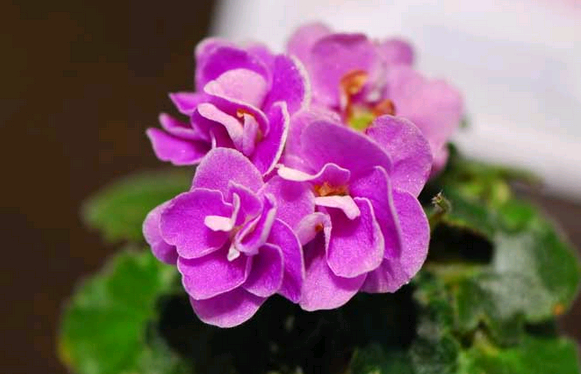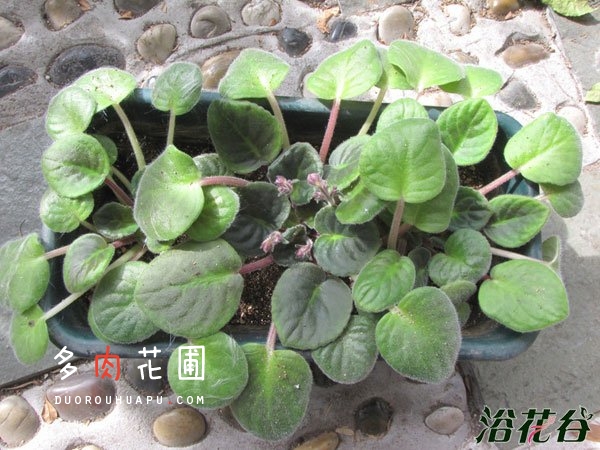Violet culture method: how to cultivate violets? The living environment of violets
How to cultivate violets:
Variety selection: the main cultivated varieties are Ada (flower white), Carmen (light yellow flower), Francis silk (flower red), Abera (flower purple), Incana (light purple flower).
Plant selection: there is no damage to the root system, and with soil blocks of strong seedlings. If it is a single flower, the strong seedling cotyledons are long oval, the real leaves are more serrated, and the seedling color is darker.
The choice of flowerpot: a shallow pot with a slightly larger mouth.
The preparation of cultivated soil: the requirement of soil is not strict, but it grows better in well drained and neutral soil.
Preparation method: humus soil, garden soil and river sand were mixed at 2:2:1.
Flower cultivation: Violet is a taproot plant and is not resistant to transplantation. in order to ensure survival, we should take more lodging soil when transplanting, do not scatter tuo, and try not to hurt the root. Once the root is injured, it is not easy to recover. The seedlings need to be divided and transplanted before the true leaves are spread. Generally, the seedlings can be planted after a split.
Before planting, some dried pig and chicken manure should be put into the soil as base fertilizer. Pour enough fixed root water after planting, shade but not sulk; potted growers should move to a cool and ventilated place, and then move to a place with plenty of sunshine after survival.
Fertilization: thin liquid fertilizer or compound fertilizer is applied every 10 days in the growing season, nitrogen fertilizer should not be too much, so as not to cause leaves to grow luxuriantly and blossom very little. If too much nitrogen fertilizer is applied, cut off part of the leaves. Let the plant grow new leaves in order to consume too much nitrogen fertilizer in the potted soil. When the nitrogen fertilizer in the soil is exhausted, the plant will blossom in large quantities. Proper application of phosphorus and potassium fertilizer in the emergence of flower buds can make the flowers large and colorful.
The growing environment of violets
Violet originated in the Mediterranean coast, warm and humid winter, cool and dry summer climate environment, now there are many introduction all over the world, north and south of our country are cultivated. The seedling stage is slightly shady, and the bud formation and flowering stage like plenty of sunshine. More resistant to cold, can withstand short-term OC around low temperature, but not resistant to frost. Avoid hot and humid climate, mildew and rain are prone to diseases. The high altitude and cool summer areas in southern China can be planted in many seasons. The general area needs to miss the hot summer and cultivate in autumn, winter and spring, mainly planting in winter and flowering in spring. Due to the pilose all over the body, violets lose less water, generally less watering in the growing period, and appropriate watering in the flowering period. The root system is extremely developed, which requires that the soil is fertile and loose, the soil layer is deep, and it is difficult to grow in heavy clay and poorly drained land. Nitrogen fertilizer was applied once at seedling stage, flower bud formation and early flowering stage, compound fertilizer was applied for 1 or 2 times.
Violet culture method
(1) Variety selection
As a potted violet, it is better to choose a dwarf double variety. In the seedling stage, the seedlings with light green cotyledons, long oval cotyledons, large engraved edges of true leaves and wavy leaves should be selected. Most of them are double petals.
(2) the size of flowerpot should be appropriate.
The planting pot should be a large basin with a diameter of about 25 cm, and the cultivated soil should be disinfected loose and fertile soil with 3 plants per pot.
(3) select the culture soil.
Violet requires loose, fertile, slightly acidic soil. When potted, we can choose the culture soil which is made up of 6 parts of rotten leaf soil and 4 parts of sand soil, or the culture soil composed of rotten leaf soil, peat soil and sand soil.
(4) the light should be suitable.
Violet likes to be half overcast. If the maintenance site is too shady, there will be less flowering and light color or only long leaves without flowering; if the light is too strong, it will cause the leaves to turn yellow and scorch.
(5) the temperature should be suitable
The suitable temperature for the growth of violets is 18 ℃ ~ 24 ℃, and the growth is poor when the temperature is more than 27 ℃. Therefore, cooling measures must be taken in summer, and the room temperature in winter should not be lower than 12 ℃.
(6) watering should be appropriate.
After planting, it should be watered thoroughly and placed in a shady place. After 3-4 days, it can be placed in a well-ventilated sunny place. However, watering should not be too much, otherwise it is easy to cause rotten roots. At the same time, be careful not to splash on the leaves, otherwise it is easy to cause the leaves to rot.
(7) fertilization should be light.
During the period of growth and development, a thin rotten liquid fertilizer or compound chemical fertilizer was applied once every 7 to 10 days. Nitrogen fertilizer should not be applied too much, otherwise the leaves will grow luxuriantly and blossom very little. Therefore, 1:1:1 is the best ratio of nitrogen, phosphorus and potassium. If more phosphorus and potassium fertilizer is applied after the emergence of flower buds, the flowers will be large and colorful.
(8) picking hearts and collecting seeds
When it grows to about 9 leaves, it is necessary to pick the heart and promote the branching. The plant grows to 40 cm and needs to be supported by thin bamboo poles. As a reserved seed, the seeds should be harvested in time before the pods turn yellow and do not crack.
How to raise violets in potted plants? the methods of cultivating potted violets are introduced here today. If you want to plant potted violets, do it quickly!
How to raise violets? how to cultivate violets?
How to raise violets, violets are common flowers and plants, and violets are easy to breed, and they can be planted indoors or outdoors, whether indoors or outdoors. We should understand the habits of violets, adapt to the environment, watering and other matters. Here are some daily violets culture methods to help new flower friends.
Violet culture method 1. Adapt to the environment
Violet flowers like the cool growth environment, and their planting in the soil with good drainage system and neutral alkali is more beneficial to the growth and development of violet flowers. Violet flowers are cold-resistant and shady, afraid of waterlogging, they come into contact with sunlight, ventilation and drainage in a good environment.
2. Requirements for preparation of basin soil
Violet is not strict with the soil, but it grows better in the soil with good drainage and neutral alkali. Generally, 5 parts of rotten leaf soil, 3 parts of garden soil, 2 parts of rotten stable fertilizer soil, or 6 parts of rotten leaf soil and 4 parts of Gaza loam soil can be mixed. At the same time, rotten leaf soil, peat soil and sand soil can also be mixed well.
3. There is plenty of sunshine
Violet likes to have plenty of sunshine, but it is also slightly resistant to semi-shade. If the light and ventilation are not adequate, they are prone to diseases and insect pests.
4. Seasonal watering control quantity
Watering violet flowers is very important during the growth period, and it should not be watered too much in spring, otherwise it will lead to the rot of violet stems and leaves and affect the flowering of flowers. Violet should be watered and sprayed around it in summer, which can effectively increase the humidity in the air, otherwise it will cause the flower pedicel to sag and shorten the flowering period. With the gradual decrease of temperature in autumn and winter, watering of violets should be reduced appropriately.
5. Temperature control in different quarters
Violet likes the environment with warm winter, cool summer and good ventilation. In winter, it can withstand short-5 ℃ low temperature and avoid dryness and heat, and the suitable temperature for flower bud differentiation is 15 ℃.
6. Fertilizing and replenishing nutrition
Violet flowers should apply light fertilizer during their growth and development. Growers should apply rarefied rotten liquid fertilizer or compound fertilizer combined with nitrogen and phosphorus every 10 days or so. At the same time, growers should pay attention to the scientific and reasonable application of nitrogen fertilizer, otherwise it will lead to the phenomenon of excessive growth of the leaves of violet flowers and affect the normal flowering of flowers. The ratio of nitrogen, phosphorus and potassium was the best at 1:1:1.
7. Pruning after flowering
The remaining flowers should be cut off after the violets so that they can branch and blossom again. The flowering period begins in mid-April and blossoms for the second time from June to July.
- Prev

Propagation method of Violet
The propagation of violets can be carried out by leaf insertion, ramet and sowing. 1. Violet can be propagated asexually by leaf cuttage, and the time should be in March-April when the growth is most exuberant. The robust plants of fine varieties should be selected-the leaf shape should be mature.
- Next

African violet breeding methods
African violet breeding method, African violet for the Gesneriaceae, perennial evergreen herbaceous flowers, stems very short, leaves fleshy, dense fine hair, Mao shape, heart shape or wave cluster, plant posture was lotus-shaped. Flowers bloom often 3~5 pedicels come out from leaf axils successively, and flowers are 3~5 or more on pedicels.
Related
- Fuxing push coffee new agricultural production and marketing class: lack of small-scale processing plants
- Jujube rice field leisure farm deep ploughing Yilan for five years to create a space for organic food and play
- Nongyu Farm-A trial of organic papaya for brave women with advanced technology
- Four points for attention in the prevention and control of diseases and insect pests of edible fungi
- How to add nutrient solution to Edible Fungi
- Is there any good way to control edible fungus mites?
- Open Inoculation Technology of Edible Fungi
- Is there any clever way to use fertilizer for edible fungus in winter?
- What agents are used to kill the pathogens of edible fungi in the mushroom shed?
- Rapid drying of Edible Fungi

